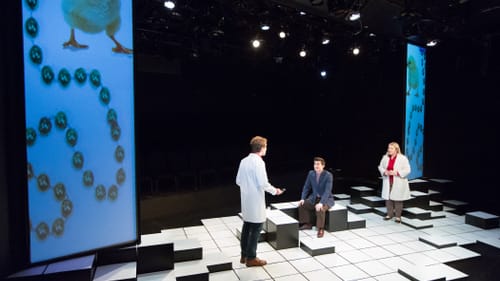Stay in the Loop
BSR publishes on a weekly schedule, with an email newsletter every Wednesday and Thursday morning. There’s no paywall, and subscribing is always free.
Are two shows better than one?
Temple Theaters presents Caryl Churchill's 'Love and Information'

While anyone producing a Caryl Churchill play is good news, Temple Theaters goes a step further by staging two different versions of Churchill's 2012 collage play Love and Information, running in repertory in the intimate Randall space.
Churchill's challenging, enigmatic works include Top Girls, Cloud Nine, and Mad Forest. Love and Information, as the title suggests, investigates intimacy and affection when the ways we process and share information via electronic sources have so radically changed. She explores this in 57 short scenes, each featuring different characters that can be rearranged within thematic sections.
While all theater productions are unique visions created by individual artists working in collaboration, Temple Theaters' pair -- each led by a different director with a different cast, staged on the same abstract set -- are more distinctive than most productions of the same play.
The problem for audiences, and for this writer, is whether and how to measure them. Seeing just one satisfies. Seeing both invites a comparison that's difficult to process fairly (one will always be first, the other second). But it also provides insight into the power of interpretation by director, actors, and designers.
My First
Director Liz Carlson, who received her Temple directing MFA in 2015, returned to stage the first version I saw. Her ensemble, five men and five women, all undergraduates, suggest characters through costume designer Elizabeth S. Ennis's base costumes, augmented by changing accessories. Scenes flow briskly, keeping us on our toes. Context is always provided, through the specific casting and Churchill's economic dialogue, but I had to work to figure out each situation.
Apollo Mark Weaver's abstract set, bisecting the square space with audience on either side, has a circuit-board look, square white floor panels at different heights accented by strings of light in the cracks between them that glow red, blue, and green. Projections designer Gary Miller provides abstract videos playing on screens at either end.
Carlson's cast maintains the script's British flavor, though they use a rich variety of accents, and music and movement add to the performance's ethereal virtual reality.

Inevitably, some scenes pop for individual spectators more than others. I was intrigued and sickened by a scientist's enthusiasm for dissecting chicken brains to see, chemically, the memories they formed in life. A young woman tells her sister she is really the sister's mother. Someone tries to explain pain to a person who feels none. A young man defends his declaration of love for someone he's only met online, who might not exist in the flesh.
My Second
Noah Herman, a second-year MFA directing candidate, staged the version I saw a day and a half later. Many of the same scenes popped for me again -- which might say more about the uniqueness of each spectator's experience than about either version -- with some exceptions. A fascinating scene about the meaning of "table" in other languages, with the doubter insisting, "I can't help feeling that it's a table," rather than any other language's term, didn't resonate with me at all in Carlson's version.
Since this was my second viewing, differences from the first were impossible to ignore. That young mother's scene with her daughter/sister plays very differently when the child is a son, as Herman has cast it. In Carlson’s version, the lovers, free to consummate their relationship because one spouse cheated, are both women. In Herman's they are a man and a woman. Carlson’s 10 actors use American accents overall, closer to our audience, perhaps further from Churchill.
Herman's production feels more grounded in reality, using more props -- which often clash with that abstract set of squares, as when actors bring on blankets and pillows, awkwardly suggesting beds, or carrying on stools when the white squares provide ample sitting room. Melanie Green's costumes have more earth tones. Herman also doesn't use floor lights, and Nick Ligon's lighting feels less abstract and more general here than in Carlson's. Miller's projections are more literal, including a cartoonish approach to the chicken research that softens its brutality with humor, and Herman's cast members often fold the screens away.
Overall, Herman's version feels more accessible, Carlson's more mysterious, but would I feel the same way if I'd seen them in reversed order?
No Verdict
Seeing the two performances, each just 80 minutes, was worthwhile. The casts are equally impressive, with young actors bravely assailing challenging material with insight and confidence. While either one works, seeing both is a rare experience not only about modern love and communication but also about theatrical interpretation. See Love and Information once, or see it twice -- either way, it's a fascinating work by a major playwright, produced and performed well.
What, When, Where
Love and Information. By Caryl Churchill. Productions directed by Liz Carlson and Noah Herman. Through April 30, 2017, at Temple University's Randall Theater, 2020 N. 13th Street, Philadelphia. (215) 204-1122 or tfma.temple.edu/events.
Sign up for our newsletter
All of the week's new articles, all in one place. Sign up for the free weekly BSR newsletters, and don't miss a conversation.

 Mark Cofta
Mark Cofta